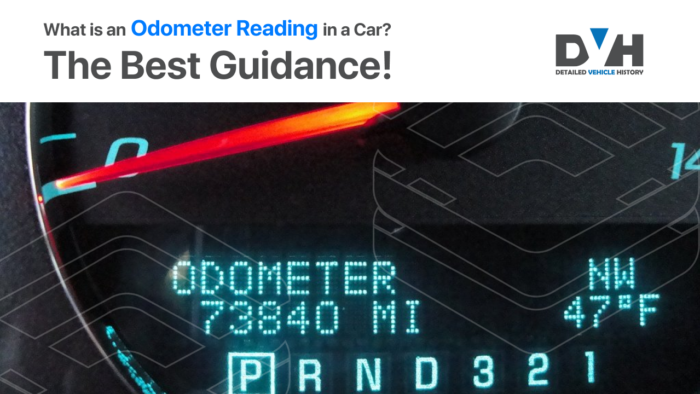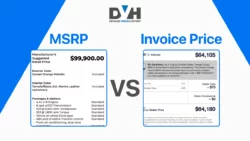Odometer Reading! Have you ever wondered what it is and how it is read? The odometer readings can be seen on the dashboard of a vehicle. They are random sets of numbers displayed that mean so much.
It can be a digital odometer or an analog odometer, no matter which one your car has. In this article, we will discuss all you need to know about Odometer reading and how to read it.
DID YOU KNOW?
The word itself is a trip down memory lane! Odometer comes from the Greek words “hodos” meaning “way” or “path” and “metron” meaning “measure”. So it translates to “way measurer”
The Basics of Odometer Readings
An odometer is an instrument used for measuring the distance traveled by a vehicle. It can be either electronic, mechanical, or both. It shares a space with the speedometer and a tachometer in most vehicle dashboards.
Crooked salesmen tamper the odometer reading when they want to reduce the mileage a car registers as having traveled. This bad and unlawful practice is often referred to as “Clocking” There are other terminologies and slang expressions used for this practice.
Importance of Odometer Readings
Odometer readings are important as they add to preventative maintenance. recommendations such as the scheduled oil changes, tire rotations, and other services are often based on mileage intervals. If these recommendations are ignored, it can lead to damages that will amount to costly repairs.
Vehicles are often priced according to the model, year, condition, and mileage. Mileage is an important factor in determining a car’s resale value.
An accurate odometer reading ensures that a vehicle is sold at a fair price for both buyers and sellers and also helps protect buyers from purchasing a vehicle with higher mileage than advertised unknowingly.
How to Check the Odometer Reading
Odometers provide an accurate and continuous reading of the total distance your vehicle traveled, including all the miles or kilometers driven throughout the car’s lifetime. It is typically displayed on the vehicle’s dashboard, close to the speedometer.
This may not be the case for all vehicles, in our previous post we discussed how to read mileage on a Tesla Vehicle you can learn more about this later.
The following is a generic way of reading the odometer. To read an odometer, look for a small rectangle usually containing six or five numbers. If your vehicle is a newer model, it may be digital. If your vehicle is older or less luxurious, it will be a physical mechanical set of numbers.
Begin by recording the current mileage shown on your car’s odometer. Drive a specific distance. After driving, observe the updated reading on the odometer.
To calculate the distance you drove, subtract the starting mileage from the new reading. As mentioned earlier.
The instrument cluster can show mileage in either miles or kilometers. In the example, the odometer (the gauge that shows distance traveled) is reading 200,000 kilometers, which is roughly equivalent to 124,274 miles (fun fact: 1 kilometer is about 0.62 miles!).
So, next time you’re behind the wheel, you’ll know exactly where to find your Mercedes A-Class’s mileage!
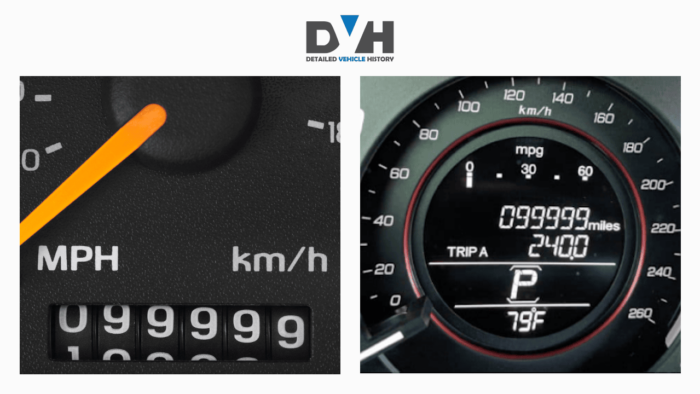
Your odometer can either be Mechanical or Digital, you might wonder how they work, let’s briefly consider the difference and how they look.
Mechanical Odometer
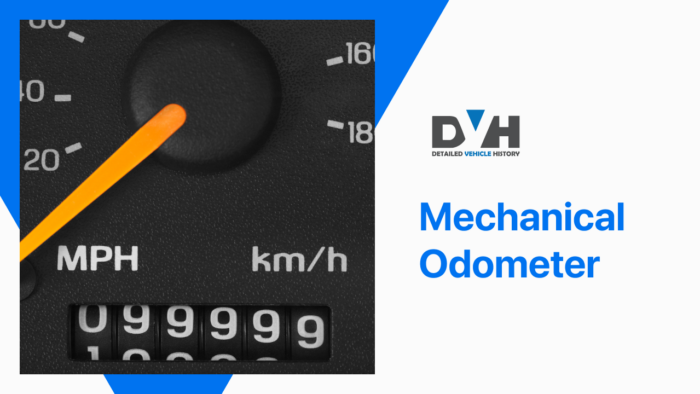
These older-styled odometers have been in vehicles for generations, and they work almost the same. Mechanical odometers are set up to track a vehicle’s tire rotation.
They track the distance traveled based on the number of rotations tracked. To determine how many rotations are required for a mile, each car manufacturer does some calculations based on the model of the vehicle.
Once this is decided on, the odometer is set to tick up one number each time it tracks the specific number of rotations. As seen in the illustration above, this particular odometer shows that the distance driven by this vehicle is 160,648km
Digital/Electronic Odometer
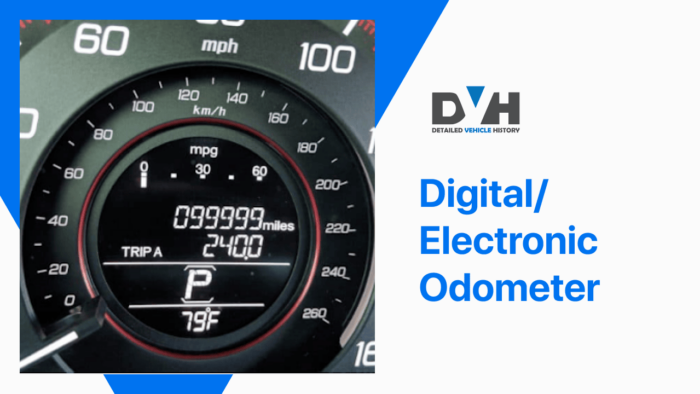
The digital odometer is more challenging to alter than the mechanical one, and it is more accurate.
The vehicle’s electrical system runs the digital odometer, and a magnetic sensor is used to count how often the gear turns with the transmission. The mileage is then reflected electronically on the dashboard.
The illustration above shows that the mileage of this vehicle is 99,999 miles, as revealed electronically.
Accuracy of Odometer Readings
There are some factors affecting the accuracy of odometer readings, such as tire pressure, changes in tire size, worn-out tires, suspension changes, gear-ratio modifications, and odometer tampering.
How to Ensure an Accurate Odometer Reading
You must ensure that your odometer reading is accurate and has not been tampered with. One way to achieve this is by getting a car mileage check report.
The odometer discrepancy found in the vehicle history report for the 2012 Honda Civic (VIN: 2HGFB2F97CH001914) is evident in the mileage records. The report shows three mileage records:
12/06/2018 – 206,000 Km
10/20/2021 – 135,000 Km
11/09/2021 – 137,500 Km
The discrepancy is highlighted by the significant drop in mileage from 206,000 Km to 135,000 Km within a relatively short period. This indicates a potential rollback or alteration of the odometer reading, raising concerns about the accuracy of the vehicle’s mileage history. Such discrepancies can impact the perceived value and reliability of the vehicle, emphasising the importance of thorough inspection and verification when considering its purchase.
Here’s the sample report to examine the odometer rollback.
The numbers in the mechanical odometer must be readable, there shouldn’t be gaps between the numbers, and it shouldn’t look crooked either.
Any misaligned numbers or numbers show that it is likely that the readings have been altered.
For digital odometers, inspecting the ECU records by a trusted mechanic can help determine the vehicle’s true mileage if you suspect fraudulent acts or if you spot any red flags.
Troubleshooting Odometer Reading Issues
A car’s odometer is an essential instrument that tracks the total distance a vehicle has traveled. If you notice your odometer isn’t displaying mileage correctly, it can be frustrating and concerning. Here’s a guide to common odometer reading issues and steps you can take to diagnose and fix them.
Common Odometer Reading Problems
Odometer not displaying mileage: This could be a completely blank display or a frozen reading.
Mileage display flickering or dimming: The odometer display might be faint or difficult to read.
Inaccurate mileage: The odometer reading doesn’t seem to match the actual distance traveled.
Steps to Fix Inaccurate Odometer Readings
While some troubleshooting steps you can try yourself, it’s important to note that tampering with odometers can be illegal. If you suspect someone has altered your odometer reading, it’s best to consult a professional mechanic. Here are some initial steps you can take for common odometer issues:
Check your owner’s manual: Your car’s manual will have specific information about your instrument cluster, including the location of fuses and how to reset the trip computer (which is different from the odometer).
Check the fuses: A blown fuse can sometimes interrupt power to the instrument cluster, causing the odometer to malfunction. Consult your owner’s manual to locate the fuse box and the fuse associated with the instrument cluster. If the fuse is blown, replace it with a fuse of the same amperage rating.
Inspect the wiring: Loose or damaged wiring connections between the odometer sensor and the instrument cluster can also cause problems. If you’re comfortable doing so, you can visually inspect the wiring for any obvious signs of damage. However, for most people, it’s advisable to consult a mechanic for this step.
Clean the odometer display: Sometimes, a dirty or dusty odometer display can make it difficult to read the mileage. Try using a microfiber cloth to gently clean the display.
Reset the instrument cluster (if applicable): Some vehicles allow you to reset the instrument cluster, which may resolve minor display issues. Refer to your owner’s manual for specific instructions on how to do this for your car model.
If none of these steps resolve the issue, it’s time to take your car to a qualified mechanic. They will have the diagnostic tools and expertise to identify the problem and recommend the appropriate repair.
How Odometer Affects Car Value
Odometer readings are pivotal in determining a car’s value, directly influencing its depreciation rate and market perception. Vehicles with lower mileage often command higher prices due to their perceived reliability and reduced wear. This lower odometer reading translates to a higher resale value, making it a valuable asset for sellers looking to maximize their returns.
However, odometer fraud remains a concern, with unscrupulous individuals resorting to illegal practices to alter readings. Methods such as rolling back the odometer, replacing it with a lower reading, or electronically manipulating digital readings are used to inflate a vehicle’s value. This underscores the importance for buyers to verify the accuracy of odometer readings to ensure a fair price based on the car’s actual mileage.
For prospective buyers, accurate odometer readings are essential for making informed decisions. They provide insights into a car’s past usage, maintenance needs, and potential resale value. By understanding the impact of mileage on a vehicle’s value and being vigilant against odometer fraud, buyers contribute to a fair and transparent used car market while safeguarding their investment in a reliable vehicle.
Frequently Asked Questions
Don’t tamper with it yourself, as it can be illegal. Take your car to a qualified mechanic for proper diagnosis and repair.
Yes, unfortunately, odometer readings can be tampered with, but it’s illegal. This is why a mechanic’s diagnosis is important. If you are buying a used car ensure to look at a detailed vehicle history report to see if there are any discrepancies associated with the odometer.
Yes, odometer reading and mileage are essentially the same thing. The odometer shows the total distance the car has traveled, which is what mileage refers to.
The odometer reading is the total distance a vehicle has traveled, displayed on the dashboard panel, usually in miles or kilometers.

